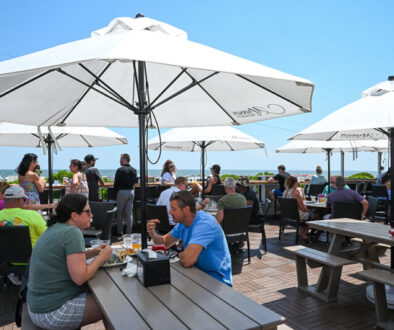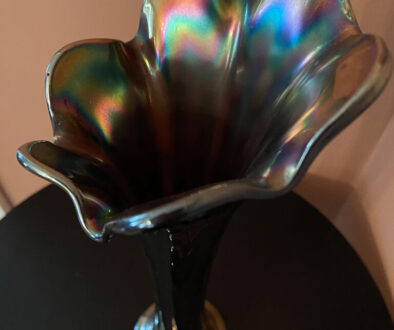Sunset Beach and the Wayward Sign
A family business, a century in the making

Was it extraterrestrials who snatched up the infamous blue and white Sunset Beach sign, or was it something more sinister? What purpose would it serve to remove an advertising sign that stood in the same spot for over 40 years? All the owners of Sunset Beach knew was that it disappeared in August of 2022. The word was out to locals to be on the lookout for the wayward sign, and theories flew. The consensus was that under the guise of night, several miscreants had removed and absconded with the cumbersome wooden 4’ by 8’, 50-pound sign. It was not an easy feat. And where was it now?
It was indeed a mystery.
Sunset Beach is located on a tiny spit of land along Delaware Bay. If you go too far, you’ll drop into the bay itself (okay, not really—metal barricades and an expansive beach will prevent you from reaching the water). It is the home of an enterprising family, the Humes, complete with a gift shop, rock and apparel shop, a small lunch grill and more, overlooking Delaware Bay and the vanishing concrete ship. But it wasn’t always that way—much happened over the previous hundred years.
Past
A century ago, Sunset Beach was a steamship landing. Passengers were loaded into small boats from the steamship and taken to shore. Later, it evolved into a steamship dock, equipped with a rickety, ever-changing wooden pier for departing passengers. The owners of the steamship Republic envisioned this area as a destination instead of a layover spot. So, the Delaware Bay House, a large hotel with a bowling alley, restaurant, shops, and amusements, was constructed, according to Cape May Point, The Illustrated History: 1875 to the Present by Joe J. Jordan.
But as transportation evolved, vacationers soon preferred the city of Cape May.
Initially horse-drawn carriageswere used; then in 1875, the Delaware Bay and Cape May Railroad was built. The first rail cars were horse drawn, followed in 1879 by steam powered engines. It ran through Cape May Point and continued onto Cape Island Turnpike (now Sunset Boulevard) ending at Cape May. In 1892, a trolley line was added, transporting passengers along the bay, past the lighthouse, and into Cape May.
In 1926 the concrete ship Atlantus, once used for shipping coal in the James River in Virginia, was sold for salvage to Jesse Rosenfeld. He planned to use its hull for ferry service between Cape May Point and Lewes, Delaware. During a storm, the ship broke loose from its mooring and went bow first, wedging itself deep into the murky bottom of the Delaware Bay. After many fruitless attempts to raise it, the ship was abandoned.

But where there’s a wharf, there are fish. This concrete blockade became an advantage, not only as a great fishing spot but for creating a beach of sea-polished stones, particularly quartz. Acting as an edifice, the Atlantus caused the water to swirl and churn, tossing and polishing the quartz. Add in tidal shifts and an occasional storm, and knee-deep stones containing the ubiquitous quartz were deposited at what was known as Diamond Beach—today, called Sunset Beach, Home of the Cape May Diamond. This phenomenon drew bathers, fishermen, and beachcombers, who by the end of the day were laden with buckets of the glimmering stones.
Curious about the lore of the Cape May Diamond? Centuries ago, a tribe of the Lenape of the Algonquin Nation, the Kechemeche, lived along Delaware Bay. They discovered the rare translucent stones which began their journey thousands of years ago along the banks of the Delaware River, rich in pockets of quartz. Some were naturally polished to a brilliance as clear as diamonds today. The tribe believed these stones held mystical powers, bringing good fortune. As whalers from New England and beyond ventured ashore, the tribe traded with them and sometimes presented their visitors with these precious stones as a bond of their friendship. Fascination with them continues to this day.
Origin of the Sunset Beach Enterprise
In the late 1920s, Frank Hughes started a boat livery business where fishermen could rent a rowboat (they had to supply their outboard motor) and fish the bay near the sunken Atlantus. Due to the popularity of the location, increasingly more people came, creating a need for a restaurant. One was built and run by Frank’s wife, Leah. After Frank passed away, Leah sold the business to Preston Shadbolt in 1955, who later sold it to Marvin Hume, “the man who loved rocks.”
An aerospace engineer, Hume was employed by McDonnell Douglas in St Louis. One day he attended a mineral and fossil convention. He was hooked and couldn’t get visions of the mesmerizing gems and rocks he’d see out of his head. He began going on excavations in Arkansas and other states, returning with loads of minerals and fossils, soon discovering a market for his truckloads of rocks. These colorful and faceted gems, along with the fossils, were sold to private collectors, as well as the Natural History Museum and the Smithsonian. Being quite the entrepreneur, Marvin made enough profit to purchase apartment complexes, then sold them. He soon left the aerospace business, returning to where he grew up, New Jersey, to sell rocks and gems.



Marvin initially rented space along the boardwalk in Atlantic City, opening a science and nature store. During the winter months, to supplement his income for himself, wife, and five children, he worked as a tool and die maker. In 1972, he purchased from Preston Shadbolt the large swath of land and buildings known as Sunset Beach. Marvin transformed the business all while maintaining his Atlantic City operation. In 1979, his son, Larry, joined fulltime, running the Sunset Beach location while his dad continued the store in Atlantic City.
It was around that time when Larry and his father installed the Sunset Beach sign, a mile away on Sunset Boulevard. As a means of advertising their shop and the concrete ship, and luring Cape May diamonds seekers, what better way than to install a large, eye-catching sky-blue-and-white sign? After obtaining approval from two neighboring private properties, they installed the sign between them. It remained there until that fateful day in August 2022. More on that later.
Sunset Beach Evolves
Sunset Beach quickly evolved while buildings on the original Shadbolt property remained intact. However, the Hume family moved and updated some of them, converting the original restaurant into a gift shop, while other buildings were restored. All of this was happening under the shadow of the Northwest Magnesite plant. To the delight of the Hume family and Cape May Point, the plant was closed in 1983 and dismantled shortly thereafter.
Traditions
When Marvin purchased Sunset Beach from Preston Shadbolt, he continued the tradition of the flag ceremony that Preston began. It was Marvin who added the dedication for fallen veterans to the ceremony. He believed that honoring fallen soldiers with their casket flags was not only a duty but a privilege. Marvin Hume was a humble man, a World War II veteran, eligible for the Purple Heart but turned it down. He had been wounded and suffered repercussions from his injuries his entire life. However, Marvin was a man of strong conviction, believing that others suffered more than him and were more deserving of receiving the honor.

In 2015, Marvin passed away at the age of 94. His son, Larry, took his father’s place of honor. The tradition of Marvin’s vision will continue via members of the Hume family. Each year, on May 1, relatives of veterans can sign up to have their loved one honored. The flag ceremony is held for eight weeks in July and August, on Monday, Wednesday, and Saturday, starting promptly at 7pm. In respect of the ceremony, all activity in the shops and grill are stopped. The cash registers are shut down, and the landline and cell phones silenced. Customers are asked to acknowledge this solemn event, and they always comply.
Today
The Hume family are active in increasing and maintaining the dunes in and surrounding their property. Initially, discarded Christmas trees were once used as dune building material, as the shifting sands encapsulated them. However, today it’s far more effective to plant dune grass and install dune fencing. The Hume family have grown the dunes, helping to move the high tide line back nearly 90 feet. As Larry spoke, it was clear that they are quite proud to help maintain the dunes, adding an environmental benefit for Lower Township. As the sea rises, citizens like this family are as important as the land they save.
Summer crowds will continue to comb the beach, relax by the water, and visit the gift shop that houses the beautiful Cape May Diamonds. The stones are polished and mounted in jewelry that comes pretty darn close to resembling a diamond. These “diamonds” are available in all shapes and sizes, set into necklaces, rings, bracelets and more, and priced to fit any budget. It was Larry’s mother-in-law, Jeanette Fox Bartolomeo, who began to collect, polish, and set the Cape May diamond into jewelry decades ago in her home studio. Today, at the age of 83, Jeanette continues to transform the quartz into jewelry, in addition to working fulltime as the jewelry counter manager. Presently, Larry’s wife, Michele, his sons, Dan and Greg, along with Larry’s sisters, Kathy and Sharon, and nephew, Anthony, make this business truly a family affair.
Larry, a man with boundless energy, is always a step ahead, and has his dad’s gift of entrepreneurship. Although retirement age is upon him, Larry remains committed, one day turning over the helm to his sons and other family members. The close-knit family is a team, always seeking ways to improve the business. The main gift shop is filled with every item imaginable, including the Cape May diamond jewelry. They take pride in their support of local businesses, authors, and more.






In addition, they travel the world to acquire crafts and foods in support of fair-trade merchants. Larry said, “We support fair trade artisans specifically in the Philippines, Ecuador, and Indonesia, as well as local folks that make products right here. We carry local products related to food, such as honey, coffee, peanut butter, hot sauces, and anything else that’s made right here in Cape May County.” They also sell products from Thailand, Australia, France, Greece, and Italy.
The Hume family is on the go throughout the year—attending trade shows, traveling overseas, and always on the lookout for unique and sustainable merchandise. Larry said that they’ll continue to operate Sunset Beach for many years to come and feels blessed to be on the beach during their working hours.
Located next to the gift shop is a miniature golf course, a big draw during the summer. My grandchildren and I visit often and yes, it’s true, I did get a hole-in-one while their backs were turned! Witnesses will confirm that.
Across from the main gift shop and tucked away is a newly refurbished cottage used as a rental during the summer months. There’s the rock and gem shop, along with an apparel shop. The Sunset Beach Grille, which I can attest made awesome sandwiches, was a busy place in the summer. It wasn’t recently leased out by the Humes and by the time you read this it will be Fish House, the latest endeavor by Zest Restaurant Group.
The Infamous Sign Found!
Remember the advertising sign caper?
It wasn’t found until a curious Temple University student, Jared Cohen, discovered the slightly bruised but still vibrant-colored sign in a trash heap on a vacant lot near the university on July 30, 2023. Yes, almost a year later! Jared, unaware of the location of Sunset Beach, posted a picture of the sign on social media, asking what he should do with it, according to a story by Amy S. Rosenberg in The Philadelphia Inquirer.
Clearly it didn’t belong where Jared found it. And where was Sunset Beach and the rightful owners? His tweet was reposted along the cyber trail until it reached the Cape May Live Facebook group. Word spread that the treasure had been found over 90 miles away on the streets of Philadelphia.

Larry asked for volunteers to retrieve the sign and received many generous offers, but John and Denise Wells did the honor. They often traveled between Pennsylvania and New Jersey, having homes in both places. They’d planned to go to Northeast Philadelphia that weekend and a detour to Temple University wouldn’t pose an issue.
John and Denise embarked on the adventure, arriving with their SUV. Jared met them and was grateful that this couple was willing to return the sign to its rightful owner. After chatting with him and giving him a generous reward from Larry Hume, it was time to retrieve the sign.
Jared led them to his friend Henry Demyan’s yard where it was stored for safekeeping. There it was in all its glory, but for a few chips and bruises. They were surprised by the sheer size and weight of it. As a group of young men heaved and securely tied the huge sign to the SUV’s roof rack, it was clear to the Wellses that the return trip would pose a challenge. But what the heck—what are friends for? John put on the SUV’s flashers and off they went. Hardly exceeding 25 miles per hour—even on the Atlantic City Expressway and the smaller highways—the shoulders often became their only option. Finally, they arrived at Sunset Beach as members of the Hume family greeted them with big smiles. The sign had returned! It now resides in its old niche on Sunset Boulevard, securely fastened with many eyes keeping a vigilant watch over it.
Like a modern-day pirate’s tale of scalawags plundering the goods with rare hopes of retrieval, this tale tells the opposite story. It serves to reinforce the lasting appeal of a family-run business that thrives by the sea on Delaware Bay.



